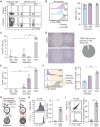γδ T Cells' Role in Donor-Specific Antibody Generation: Insights From Transplant Recipients and Experimental Models
- PMID: 39944220
- PMCID: PMC11815947
- DOI: 10.3389/ti.2025.12859
γδ T Cells' Role in Donor-Specific Antibody Generation: Insights From Transplant Recipients and Experimental Models
Abstract
The generation of donor-specific antibodies (DSA) requires that alloreactive B cells receive help from follicular helper T (TFH) cells. Recent works have suggested that γδ T cells could contribute to T cell-dependent humoral responses, leading us to investigate their role in DSA generation. Analysis of a cohort of 331 kidney transplant recipients found no relation between the number of circulating γδ T cells and the risk to develop DSA. Coculture models demonstrated that activated γδ T cells were unable to promote the differentiation of B cells into plasma cells, ruling out that they can be "surrogate" TFH. In line with this, γδ T cells preferentially localized outside the B cell follicles, in the T cell area of lymph nodes, suggesting that they could instead act as "antigen-presenting cell" (APC) to prime αβ TFH. This hypothesis was proven wrong since γδ T cells failed to acquire APC functions in vitro. These findings were validated in vivo by the demonstration that following transplantation with an allogeneic Balb/c (H2d) heart, wild-type and TCRδKO C57BL/6 (H2b) mice developed similar DSA responses, whereas TCRαKO recipients did not develop DSA. We concluded that the generation of DSA is unfazed by the absence of γδ T cells.
Keywords: B cell; donor specific antibody (DSA); gamma delta T cell; humoral response; translational science.
Copyright © 2025 Charmetant, Rigault, Chen, Kaminski, Visentin, Taton, Marseres, Mathias, Koenig, Barba, Merville, Graff-Dubois, Morelon, Déchanet-Merville, Dubois, Duong van Huyen, Couzi and Thaunat.
Conflict of interest statement
The authors declare that the research was conducted in the absence of any commercial or financial relationships that could be construed as a potential conflict of interest.
Figures




References
-
- Sicard A, Phares TW, Yu H, Fan R, Baldwin WM, Fairchild RL, et al. The Spleen Is the Major Source of Antidonor Antibody-Secreting Cells in Murine Heart Allograft Recipients. Am J Transpl Off J Am Soc Transpl Am Soc Transpl Surg (2012) 12(7):1708–19. 10.1111/j.1600-6143.2012.04009.x - DOI - PMC - PubMed
MeSH terms
Substances
LinkOut - more resources
Full Text Sources
Medical
Miscellaneous

